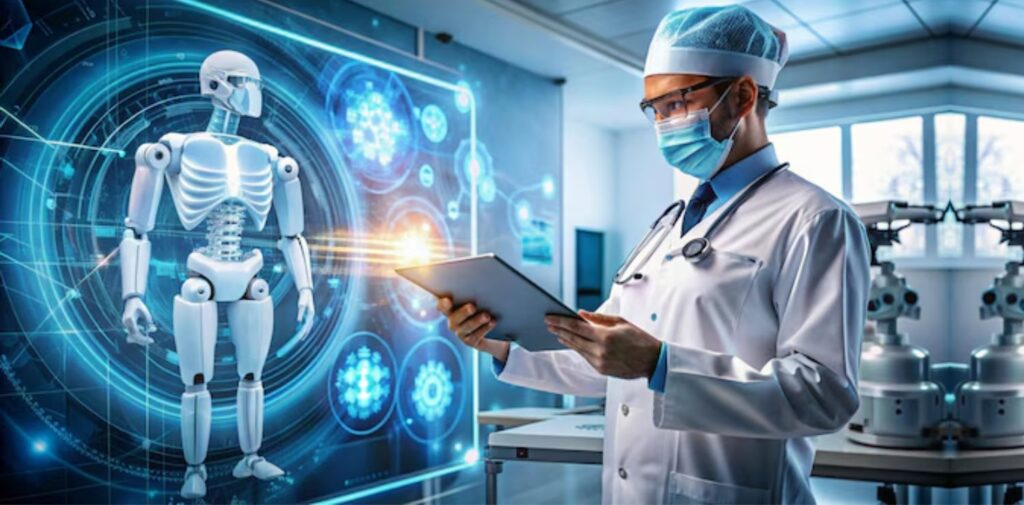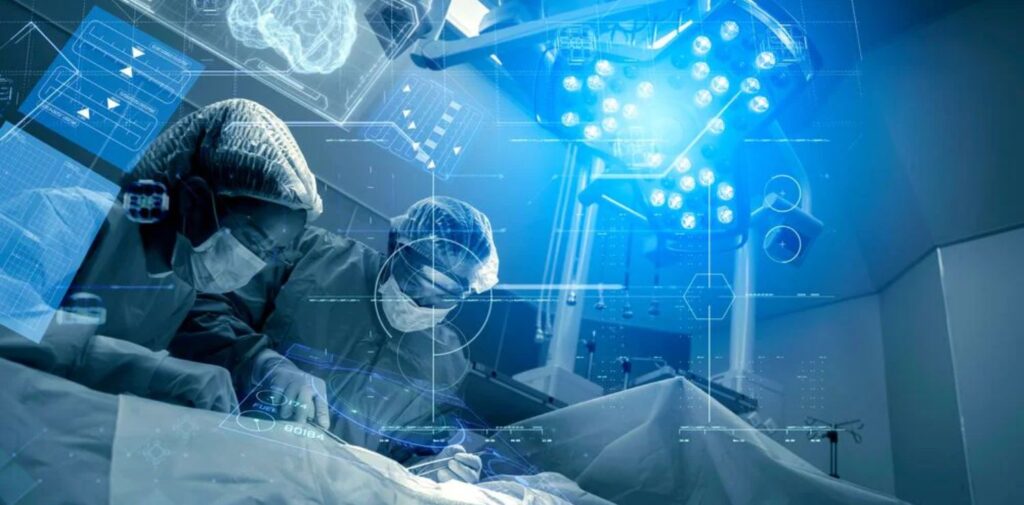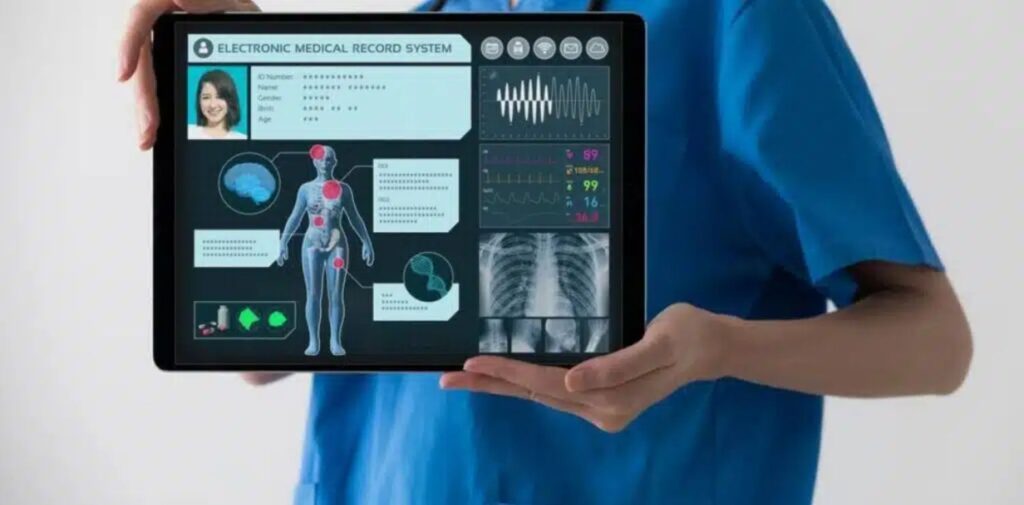The future of healthcare is incredibly exciting, thanks to groundbreaking advancements in technology and artificial intelligence (AI). From improving patient care to making healthcare more accessible around the world, these innovations are transforming the way we approach health. Technology, especially AI, telemedicine, and other digital tools, are creating solutions to some of the biggest health challenges we face today.
In this article, we’ll explore how these advancements are revolutionizing healthcare delivery, improving outcomes for patients, and making healthcare more affordable and accessible across the globe.
AI: The Brain Behind Healthcare Innovation
Artificial Intelligence, or AI, is quickly becoming one of the most powerful tools in healthcare. It refers to machines and software that can learn from data, make decisions, and solve problems on their own, much like the human brain. AI is already being used in several areas of healthcare, and its potential is vast.
1. Diagnosing Diseases Faster and More Accurately
AI can analyze large amounts of data much faster than humans. In medical imaging, for example, AI algorithms are now used to help doctors read X-rays, MRIs, and CT scans. These AI systems can identify patterns that might be missed by the human eye, helping doctors detect conditions like cancer, heart disease, and strokes early on. Early diagnosis is crucial because it often leads to better treatment outcomes.
AI is also being used to predict disease outbreaks and track the spread of infectious diseases. By analyzing patterns in data from various sources (like social media, news reports, and health databases), AI can help predict where an outbreak might occur, allowing health organizations to prepare in advance and respond quickly.
2. Personalized Treatment Plans
AI is helping doctors develop personalized treatment plans for patients. By analyzing genetic information, lifestyle habits, and medical history, AI systems can suggest the best treatment options for an individual. This personalized approach increases the chances of successful treatment and reduces the risk of side effects.
For instance, in cancer treatment, AI can analyze a patient’s genetic data and suggest specific drugs or therapies that are more likely to work for them. This reduces the trial-and-error approach to finding the right treatment, saving time and improving the patient’s chances of recovery.

Telemedicine: Healthcare at Your Fingertips
Telemedicine, or remote healthcare, has been around for a while, but its use has grown dramatically, especially after the COVID-19 pandemic. Telemedicine allows patients to consult with doctors via video calls, phone calls, or even chat messages without having to visit a clinic in person. This has made healthcare more convenient, especially for those living in remote areas or for people who have difficulty traveling.
1. Access to Healthcare Anywhere
Telemedicine is helping to bridge the gap between urban and rural healthcare access. Many people in rural areas struggle to see specialists because they are too far away or because there aren’t enough healthcare professionals. Through telemedicine, patients can have a consultation with a specialist from the comfort of their homes, no matter where they live.
For example, a person living in a rural area might need to see a heart specialist. Instead of traveling hundreds of miles to the nearest city, they can have a video consultation with a cardiologist, who can diagnose their condition, offer advice, and even prescribe medications if necessary.
2. Reducing Wait Times and Healthcare Costs
Telemedicine can also reduce the burden on hospitals and clinics, especially in times of crisis, such as during the COVID-19 pandemic. It helps ease the pressure on healthcare systems by reducing the number of patients who need to be physically present. This means doctors can spend more time with those who need in-person care, and patients with less severe symptoms can get the treatment they need remotely.
Additionally, telemedicine often comes at a lower cost than in-person visits. This makes it an affordable option for people who may not have easy access to healthcare or who cannot afford expensive treatments.

Robotics and Automation: The Future of Surgery
In recent years, robotics has taken center stage in surgical procedures. Robots, controlled by surgeons, are being used to perform precise and minimally invasive surgeries. These robotic systems help surgeons make more accurate incisions, which can lead to faster recovery times, less pain, and fewer complications for patients.
1. Safer and More Accurate Surgeries
One of the most significant advantages of robotic surgery is the precision it offers. Robotic systems are equipped with advanced cameras and instruments that provide surgeons with a detailed, magnified view of the surgical area. This allows for more accurate movements and smaller incisions, which reduces the risk of infection and speeds up recovery.
For example, robotic surgery is commonly used in procedures like prostate cancer surgery and minimally invasive heart surgeries. The technology helps surgeons perform complex tasks with greater control and less human error.
2. Automation in Healthcare Administration
Beyond surgery, automation is also improving the administrative side of healthcare. AI-powered systems are now being used to handle tasks like scheduling, billing, and maintaining patient records. This reduces the workload on healthcare professionals and allows them to focus more on patient care. It also helps streamline operations, making healthcare services more efficient and cost-effective.
Wearable Health Devices: Monitoring Health in Real-Time
Wearable devices, such as smartwatches and fitness trackers, are becoming a common part of our daily lives. These devices are not just for tracking physical activity anymore. They are now equipped with sensors that can monitor various aspects of health in real time, such as heart rate, blood pressure, and even blood oxygen levels.
1. Early Detection of Health Problems
Wearables can alert users to potential health problems before they become serious. For example, some smartwatches can detect irregular heart rhythms, which could indicate conditions like atrial fibrillation (AFib). If the device notices something unusual, it sends an alert to the user, prompting them to see a doctor. This type of early detection can save lives and prevent long-term health issues.
2. Managing Chronic Conditions
Wearable devices are also helping patients manage chronic conditions like diabetes and hypertension. Continuous glucose monitors, for example, allow people with diabetes to track their blood sugar levels throughout the day. This helps them manage their condition more effectively and avoid dangerous spikes or drops in blood sugar.

Digital Health Records: Streamlining Patient Information
One of the most significant changes in healthcare is the move toward electronic health records (EHRs). In the past, patient information was stored on paper, making it difficult to share and update. With EHRs, doctors and healthcare providers can easily access patient data, share it with specialists, and keep it up to date.
1. Better Coordination of Care
EHRs allow multiple healthcare providers to access the same information, which improves communication and coordination among doctors, nurses, and specialists. For example, if a patient visits their primary care doctor and then needs to see a specialist, the specialist can quickly access the patient’s medical history, lab results, and other relevant information. This reduces the risk of errors and ensures that patients receive the best possible care.
2. Reduced Paperwork and Administrative Burden
By moving to digital records, healthcare systems can reduce the amount of time spent on paperwork. This makes the entire process more efficient, from scheduling appointments to billing and insurance claims. As a result, healthcare providers can spend more time focusing on their patients and less time on administrative tasks.
The Global Impact: Making Healthcare Accessible for All
Technology has the potential to revolutionize global healthcare. Innovations like AI, telemedicine, and wearable devices are helping to address some of the world’s most pressing health challenges, such as:
- Health disparities: Many people around the world, especially in low-income and rural areas, have limited access to healthcare. Telemedicine and AI can help bridge this gap by providing remote consultations and improving diagnostics.
- Aging populations: As the global population ages, there will be an increasing demand for healthcare services. Technology can help manage chronic diseases, monitor elderly patients, and reduce the strain on healthcare systems.
- Pandemics and emergencies: During global health crises, such as the COVID-19 pandemic, technology has proven essential in managing outbreaks, providing remote care, and distributing health information to the public.
Conclusion: Future of Healthcare
Technology and artificial intelligence are transforming healthcare in ways we could never have imagined just a few years ago. From AI-powered diagnostics to wearable health devices and telemedicine, these advancements are improving patient care, reducing costs, and making healthcare more accessible around the world.
As technology continues to evolve, the future of healthcare looks brighter than ever. With these tools, we have the potential to tackle some of the world’s most significant health challenges and provide better care for everyone, no matter where they live or what their circumstances are. The future of healthcare is here, and it’s powered by technology.




